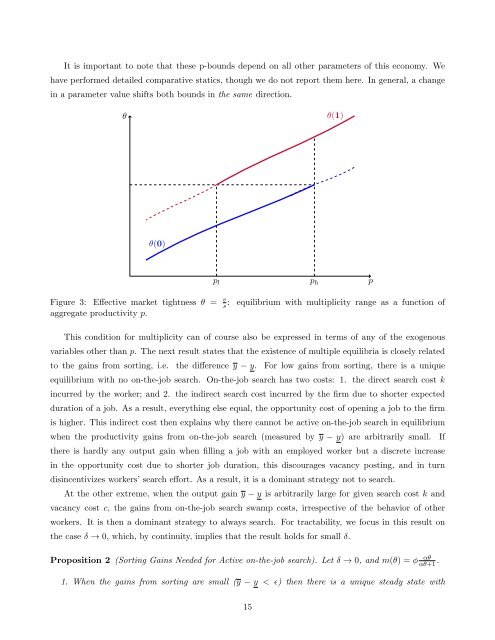Unemployment cycles
WP201526
WP201526
You also want an ePaper? Increase the reach of your titles
YUMPU automatically turns print PDFs into web optimized ePapers that Google loves.
It is important to note that these p-bounds depend on all other parameters of this economy. We<br />
have performed detailed comparative statics, though we do not report them here. In general, a change<br />
in a parameter value shifts both bounds in the same direction.<br />
θ<br />
θ(1)<br />
θ(0)<br />
p l<br />
p h<br />
p<br />
Figure 3: Effective market tightness θ = v s<br />
: equilibrium with multiplicity range as a function of<br />
aggregate productivity p.<br />
This condition for multiplicity can of course also be expressed in terms of any of the exogenous<br />
variables other than p. The next result states that the existence of multiple equilibria is closely related<br />
to the gains from sorting, i.e. the difference y − y. For low gains from sorting, there is a unique<br />
equilibrium with no on-the-job search. On-the-job search has two costs: 1. the direct search cost k<br />
incurred by the worker; and 2. the indirect search cost incurred by the firm due to shorter expected<br />
duration of a job. As a result, everything else equal, the opportunity cost of opening a job to the firm<br />
is higher. This indirect cost then explains why there cannot be active on-the-job search in equilibrium<br />
when the productivity gains from on-the-job search (measured by y − y) are arbitrarily small.<br />
there is hardly any output gain when filling a job with an employed worker but a discrete increase<br />
in the opportunity cost due to shorter job duration, this discourages vacancy posting, and in turn<br />
disincentivizes workers’ search effort. As a result, it is a dominant strategy not to search.<br />
At the other extreme, when the output gain y − y is arbitrarily large for given search cost k and<br />
vacancy cost c, the gains from on-the-job search swamp costs, irrespective of the behavior of other<br />
workers. It is then a dominant strategy to always search. For tractability, we focus in this result on<br />
the case δ → 0, which, by continuity, implies that the result holds for small δ.<br />
Proposition 2 (Sorting Gains Needed for Active on-the-job search). Let δ → 0, and m(θ) = φ αθ<br />
αθ+1 .<br />
1. When the gains from sorting are small (y − y < ɛ) then there is a unique steady state with<br />
If<br />
15


